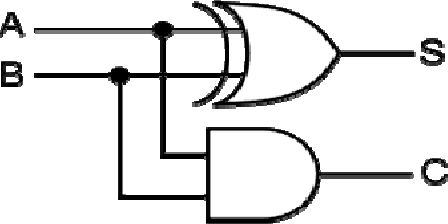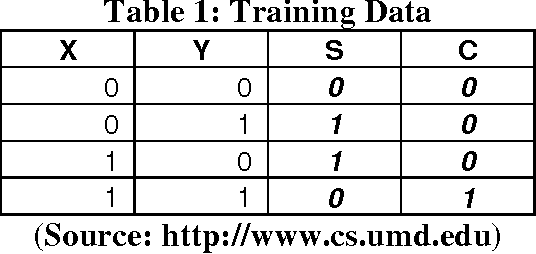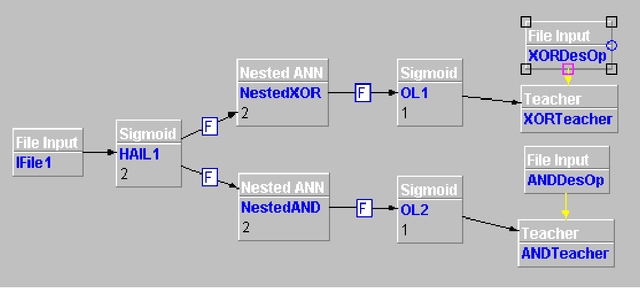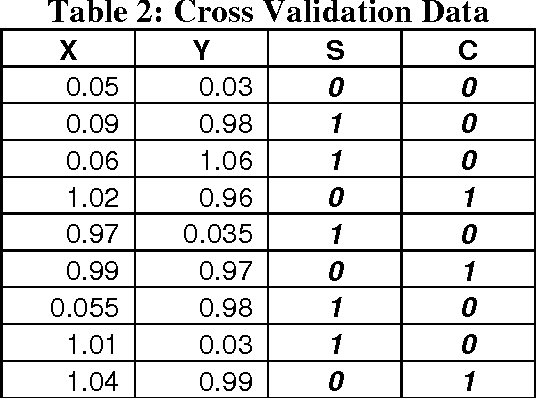T. V. Prasad
Representation of a Sentence using a Polar Fuzzy Neutrosophic Semantic Net
May 02, 2014



Abstract:A semantic net can be used to represent a sentence. A sentence in a language contains semantics which are polar in nature, that is, semantics which are positive, neutral and negative. Neutrosophy is a relatively new field of science which can be used to mathematically represent triads of concepts. These triads include truth, indeterminacy and falsehood, and so also positivity, neutrality and negativity. Thus a conventional semantic net has been extended in this paper using neutrosophy into a Polar Fuzzy Neutrosophic Semantic Net. A Polar Fuzzy Neutrosophic Semantic Net has been implemented in MATLAB and has been used to illustrate a polar sentence in English language. The paper demonstrates a method for the representation of polarity in a computers memory. Thus, polar concepts can be applied to imbibe a machine such as a robot, with emotions, making machine emotion representation possible.
* arXiv admin note: text overlap with arXiv:math/0101228, arXiv:math/0412424, arXiv:math/0306384 by other authors
Sketch Recognition using Domain Classification
Nov 12, 2012



Abstract:Conceptualizing away the sketch processing details in a user interface will enable general users and domain experts to create more complex sketches. There are many domains for which sketch recognition systems are being developed. But they entail image-processing skill if they are to handle the details of each domain, and also they are lengthy to build. The implemented system goal is to enable user interface designers and domain experts who may not have proficiency in sketch recognition to be able to construct these sketch systems. This sketch recognition system takes in rough sketches from user drawn with the help of mouse as its input. It then recognizes the sketch using segmentation and domain classification, the properties of the user drawn sketch and segments are searched heuristically in the domains and each figures of each domain, and finally it shows its domain, the figure name and properties. It also draws the sketch smoothly. The work is resulted through extensive research and study of many existing image processing and pattern matching algorithms.
A Hindi Speech Actuated Computer Interface for Web Search
Nov 12, 2012



Abstract:Aiming at increasing system simplicity and flexibility, an audio evoked based system was developed by integrating simplified headphone and user-friendly software design. This paper describes a Hindi Speech Actuated Computer Interface for Web search (HSACIWS), which accepts spoken queries in Hindi language and provides the search result on the screen. This system recognizes spoken queries by large vocabulary continuous speech recognition (LVCSR), retrieves relevant document by text retrieval, and provides the search result on the Web by the integration of the Web and the voice systems. The LVCSR in this system showed enough performance levels for speech with acoustic and language models derived from a query corpus with target contents.
* 7 pages
Hybrid Systems for Knowledge Representation in Artificial Intelligence
Nov 12, 2012



Abstract:There are few knowledge representation (KR) techniques available for efficiently representing knowledge. However, with the increase in complexity, better methods are needed. Some researchers came up with hybrid mechanisms by combining two or more methods. In an effort to construct an intelligent computer system, a primary consideration is to represent large amounts of knowledge in a way that allows effective use and efficiently organizing information to facilitate making the recommended inferences. There are merits and demerits of combinations, and standardized method of KR is needed. In this paper, various hybrid schemes of KR were explored at length and details presented.
* 6 pages
The Future of Neural Networks
Sep 20, 2012

Abstract:The paper describes some recent developments in neural networks and discusses the applicability of neural networks in the development of a machine that mimics the human brain. The paper mentions a new architecture, the pulsed neural network that is being considered as the next generation of neural networks. The paper also explores the use of memristors in the development of a brain-like computer called the MoNETA. A new model, multi/infinite dimensional neural networks, are a recent development in the area of advanced neural networks. The paper concludes that the need of neural networks in the development of human-like technology is essential and may be non-expendable for it.
* 6 pages, 2 figures
Application of Fuzzy Mathematics to Speech-to-Text Conversion by Elimination of Paralinguistic Content
Sep 20, 2012


Abstract:For the past few decades, man has been trying to create an intelligent computer which can talk and respond like he can. The task of creating a system that can talk like a human being is the primary objective of Automatic Speech Recognition. Various Speech Recognition techniques have been developed in theory and have been applied in practice. This paper discusses the problems that have been encountered in developing Speech Recognition, the techniques that have been applied to automate the task, and a representation of the core problems of present day Speech Recognition by using Fuzzy Mathematics.
* 6 pages, 3 figures, 1 table. arXiv admin note: text overlap with arXiv:1001.2267 by other authors
Applicability of Crisp and Fuzzy Logic in Intelligent Response Generation
Sep 20, 2012Abstract:This paper discusses the merits and demerits of crisp logic and fuzzy logic with respect to their applicability in intelligent response generation by a human being and by a robot. Intelligent systems must have the capability of taking decisions that are wise and handle situations intelligently. A direct relationship exists between the level of perfection in handling a situation and the level of completeness of the available knowledge or information or data required to handle the situation. The paper concludes that the use of crisp logic with complete knowledge leads to perfection in handling situations whereas fuzzy logic can handle situations imperfectly only. However, in the light of availability of incomplete knowledge fuzzy theory is more effective but may be disadvantageous as compared to crisp logic.
* 4 pages, 1 table
A Neuro-Fuzzy Technique for Implementing the Half-Adder Circuit Using the CANFIS Model
Sep 20, 2012



Abstract:A Neural Network, in general, is not considered to be a good solver of mathematical and binary arithmetic problems. However, networks have been developed for such problems as the XOR circuit. This paper presents a technique for the implementation of the Half-adder circuit using the CoActive Neuro-Fuzzy Inference System (CANFIS) Model and attempts to solve the problem using the NeuroSolutions 5 Simulator. The paper gives the experimental results along with the interpretations and possible applications of the technique.
* 7 pages, 9 figures, 7 tables
Speech Signal Filters based on Soft Computing Techniques: A Comparison
Sep 20, 2012



Abstract:The paper presents a comparison of various soft computing techniques used for filtering and enhancing speech signals. The three major techniques that fall under soft computing are neural networks, fuzzy systems and genetic algorithms. Other hybrid techniques such as neuro-fuzzy systems are also available. In general, soft computing techniques have been experimentally observed to give far superior performance as compared to non-soft computing techniques in terms of robustness and accuracy.
* 5 pages
Hybrid technique for effective knowledge representation & a comparative study
Sep 18, 2012



Abstract:Knowledge representation (KR) and inference mechanism are most desirable thing to make the system intelligent. System is known to an intelligent if its intelligence is equivalent to the intelligence of human being for a particular domain or general. Because of incomplete ambiguous and uncertain information the task of making intelligent system is very difficult. The objective of this paper is to present the hybrid KR technique for making the system effective & Optimistic. The requirement for (effective & optimistic) is because the system must be able to reply the answer with a confidence of some factor. This paper also presents the comparison between various hybrid KR techniques with the proposed one.
* 15 pages,9 figures, 1 table, Pablished in IJCSES,International Journal of Computer Science & Engineering Survey Vol.3, No.4, August 2012
 Add to Chrome
Add to Chrome Add to Firefox
Add to Firefox Add to Edge
Add to Edge